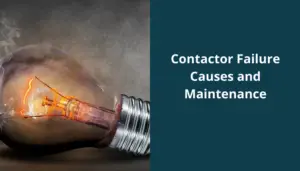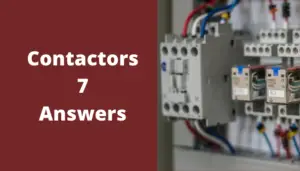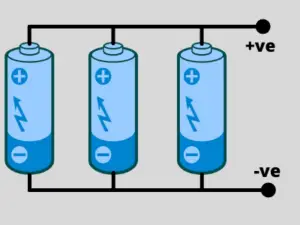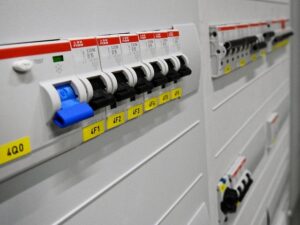Table of Contents
What is a GFCI circuit Breaker?
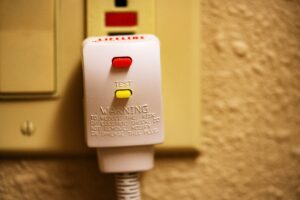
A GFCI (Ground Fault Circuit Interrupter) circuit breaker is a specialized type of breaker designed to protect people from electrical shock caused by ground faults. It does this by monitoring the flow of electricity in a circuit and quickly shutting off power if it detects an imbalance between the hot and neutral wires, typically caused by current leaking to the ground (such as through a person).
A GFCI circuit breaker monitors the imbalance of electrical current between the hot and neutral wires within a circuit.
If it detects a leakage of current, indicating a ground fault or a short circuit, it quickly interrupts the circuit, cutting off the power supply.
This rapid response helps prevent electric shocks and electrical fires caused by ground faults.
GFCI circuit breakers are commonly used where standard GFCI outlets might not be suitable or accessible, such as for large appliances or in areas where water is present, like kitchens, bathrooms, and outdoor spaces.
Uses and Importance of GFCI Circuit Breaker
GFCI circuit breakers play a vital role in electrical safety, especially in areas prone to electrical hazards. Their key benefits and uses include:
Protection Against Electric Shocks
GFCI circuit breakers are essential for preventing electric shocks in locations where water is present, such as bathrooms, kitchens, laundry rooms, and outdoor spaces. They rapidly shut off the circuit upon detecting a ground fault, reducing the risk of severe or fatal shocks.
Prevention of Electrical Fires
By quickly responding to ground faults and short circuits, GFCI circuit breakers help prevent electrical fires. They disconnect the power supply when an electrical imbalance occurs, minimizing the risk of overheating and fire hazards.
Comprehensive Circuit Protection
Unlike GFCI outlets that safeguard only a single receptacle, GFCI circuit breakers provide protection for an entire branch circuit. This ensures that all connected outlets and appliances are secured, making them particularly useful in high-risk areas such as kitchens and workshops.
Compliance with Electrical Codes
Modern building codes require GFCI protection in specific areas to enhance electrical safety. Installing GFCI circuit breakers helps homeowners and builders comply with these regulations, avoiding legal issues while ensuring a safer environment for occupants.
I have a detailed article about, Why is your circuit breaker is tripping, read it for more information
How a GFCI Circuit Breaker Works
A GFCI (Ground Fault Circuit Interrupter) circuit breaker continuously monitors the flow of electricity in a circuit. Its primary function is to detect any imbalance between the current flowing through the hot wire and the current returning through the neutral wire.
Step-by-Step Working Principle:
-
Normal Operation:
- In a properly functioning electrical circuit, the current entering through the hot wire should be equal to the current returning via the neutral wire.
- For example, if 10 amps are flowing through the hot wire, exactly 10 amps should be returning through the neutral wire.
-
Detecting a Ground Fault:
- If there is a leakage of current due to a ground fault (e.g., electricity unintentionally flowing through a person, water, or damaged wiring), the returning current in the neutral wire will be less than the outgoing current in the hot wire.
- This difference can be as small as 4–6 milliamps (mA), which is enough to cause serious injury or electrocution.
-
Immediate Power Cutoff:
- The GFCI breaker detects this imbalance and trips (shuts off power) within milliseconds, preventing harm.
- This rapid response helps protect people from severe electric shocks and reduces the risk of electrical fires caused by faulty wiring.
Example Scenario:
- Suppose a person accidentally touches a live wire while standing on a wet floor. Some of the currents may flow through their body to the ground instead of returning through the neutral wire.
- The GFCI breaker senses this imbalance and immediately disconnects power, preventing serious injury or death.
This quick and automatic shutoff mechanism makes GFCI circuit breakers essential for electrical safety in homes and workplaces, particularly in areas exposed to moisture.
Difference Between GFCI Breaker and GFCI Outlet
Both GFCI breakers and GFCI outlets serve the same purpose—protecting against electric shocks by detecting ground faults and cutting off power. However, they differ in coverage and application.
1. GFCI Breaker
Protection Scope:
- Provides GFCI protection for the entire circuit, meaning all outlets and devices connected to that circuit are safeguarded.
Installation Location:
- Installed in the electrical panel (breaker box), replacing a standard circuit breaker.
Best Use Cases:
- Ideal for protecting multiple outlets in high-risk areas like kitchens, bathrooms, garages, basements, and outdoor circuits.
- Recommended when you want one centralized protection point instead of installing multiple GFCI outlets.
2. GFCI Outlet
Protection Scope:
- Protects only itself and any downstream outlets (outlets wired to its load terminals).
Installation Location:
- Installed in place of a standard wall outlet.
Best Use Cases:
- Ideal for specific outlets in wet or damp areas like bathrooms, kitchens, and outdoor locations.
- Useful when you need localized GFCI protection rather than securing an entire circuit.
Which One Should You Choose?
- Use a GFCI breaker if you want whole-circuit protection or if the electrical panel is easier to access for resets.
- Use a GFCI outlet if you only need to protect a few outlets or don’t want to modify the breaker panel.
I Wrote a detailed article about CB tripping. I highly recommend reading, Reasons for CB tripping, What Should You Do?
Don’t Leave Empty-Handed!
Install my Free Android App on Google Play:
Electrical Cables Most Common Tables “Cables Tables”
And, my Electrical Calculations App “Fast Electrical Calculator”
Discover more great content by subscribing to My channel
Looking to stay ahead of the game in the world of electrical engineering? Subscribe to my YouTube channel and gain access to exclusive content you won’t find anywhere else!
The staff I recommend
(Amazon Affiliate Links to products I believe are high quality):
- Economy 120 Volt/60Hz AC Power Source – Step-Down Voltage & Frequency Converters 1800W
- UNI-T Digital Multimeter Tester UT139C
- 50-Amp Extension Cord for RV “100ft”
- Voltage Stabilizer 110/220v
- Hair Dryer “best selling“
- TOSHIBA EM131A5C-BS Countertop Microwave Ovens
Disclaimer: This contains affiliate links to Amazon products. I may earn a commission for purchases made through these links.

